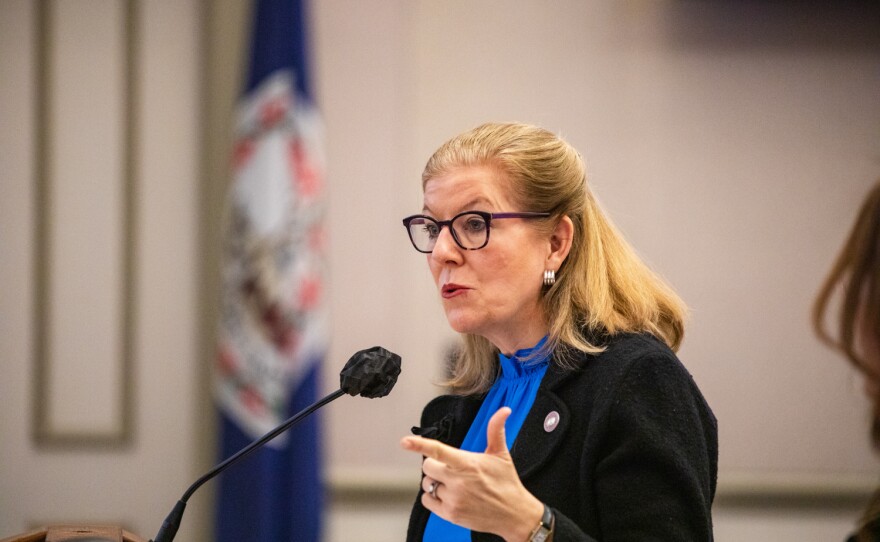Gov. Glenn Youngkin's education administration repeatedly has stressed a desire to raise the state's education standards in order to score higher on national tests.
This was the message during a May press conference on student achievement and again Monday after the release of 2022 data from the National Assessment of Educational Progress. State Secretary of Education Aimee Guidera said the data “reinforces our commitment to raise expectations for students in schools to support them in meeting those high standards and to hold them accountable for results.”
But the NAEP test is very different from Virginia’s Standards of Learning tests, and experts warn against comparing their results. VPM News spoke with some education policy experts to unpack what exactly these tests are, what they measure, and how they should and shouldn't be used.
What is the NAEP test and how is it different from Virginia’s SOL tests?
NAEP is a national, standardized test developed a few decades ago that’s designed to measure how students are learning across states, primarily for reading and math. It’s not a high-stakes test, unlike Virginia’s SOLs which determine if schools are accredited.
Kim Bridges, professor for VCU’s school of education, points to a visualization about the four types of testing that helps differentiate the different purposes of these two tests. NAEP is considered a monitoring test because it’s meant to monitor trends and is not a high-stakes test like the SOLs, which are – and fall into the accountability testing category. High-stakes tests can impact teacher and school administrator evaluations.
And NAEP doesn’t measure individual student’s achievement across time, like the state standards do. In fact, no one student takes the entire exam, and individual schools and students don’t even receive their results. Bridges said NAEP captures “two-year snapshots of a subset of students. It’s never the same group of students, you’re not following a cohort of students’ progress. Whereas with the SOLs, all Virginia public school students take them.”
Complicating matters, the tests use the same terminology to refer to different levels of student achievement. Both tests rate students’ results as “basic,” “proficient” or “advanced,” but the NAEP standards are higher.
James Harvey, retired founder of the National Superintendents Roundtable, told VPM News that the definition of “proficiency” on the NAEP test is misleading and makes it seem like students are doing worse than they actually are. In a 2018 report, he argued the scores should be renamed as “low,” “intermediate,” “high,” and “advanced.”
“What this study shows is that if you applied the NAEP definition of proficiency to international test scores, not a single nation can demonstrate that even half of its students could be classified as proficient in grade four reading,” Harvey said.
In the absence of changing the “global pie in the sky” rating, Harvey said NAEP’s “basic” score is a better indicator of whether a student is learning on grade level. That’s what the National Center for Education Statistics – the organization that funds the NAEP test – has said as well.
About twice as many Virginia students met the “basic” level as “proficient” this year, though the percentage of students meeting the “basic” level declined since 2019.
Virginia Superintendent of Public Instruction Jillian Balow said during the administration’s press conference Monday that “using the SOL scores, we report that two-thirds of fourth graders are doing well. And that’s just not true. Parents and teachers cannot take action unless they all know that we are nowhere near two-thirds proficient with our students.”
For Taikein Cooper, executive director of Virginia Excels, the statement is a reminder of the administration’s push to close the “honesty gap” (the alleged gap between Virginia’s state testing standards and proficiency definition and the national NAEP standards and proficiency definition). Cooper said that push “isn’t very honest,” and other education experts also agree that comparing state standards with NAEP standards is problematic.
“Unfortunately, whenever we get data, we’re quick to point the finger and blame someone else. In Virginia, we’ve developed this culture — probably because of high-stakes testing and some of those accountability measures over the years — but I think we’re missing a true opportunity to do some things differently,” Cooper said. “And to actually acknowledge and add context to what students have been experiencing over the last two and a half years.”
Bridges said the statement reminds her of previous misuse of NAEP data, which others have coined “misnaepery.”
“There are three big ‘misnaepery’ violations,” Bridges said. “And the first one is to use the NAEP data to serve advocacy goals, to blame or to advance particular policy solutions.”
Experts call for increased funding to address disparities in achievement
Despite the politicization of both state and national standards, education policy experts VPM News spoke with all agreed that more funding and resources are necessary to address the glaring disparities in who has fallen behind the most during the pandemic.
Chad Stewart, a policy analyst for the Virginia Education Association, pointed out that Black and Hispanic students — as well as English language learners — saw the steepest declines, most pronounced in 4th grade reading and math.
“Students have been struggling over the pandemic, particularly students that face the most barriers to education. And that's exactly what these results beared out,” Stewart said.
He also pointed out that Virginia schools that aren’t fully accredited have recently received less funding per student on average than fully accredited schools, according to a VEA analysis.
“And that's kind of upside down from what we know is needed based on research and funding adequacy,” Stewart said. “These are schools with our highest concentrations of students who live in poverty, many of them are in neighborhoods that have been historically redlined and deliberately disinvested in through state-sanctioned policy over generations.”
He said research suggests states need to spend up to 200% more on students living in poverty in order for them to perform on par with peers from higher-income families .



